B.P.R.D.: The Universal Machine: Bye-Bye Frogs, Hello Gothic Nightmare
By Mark Wheaton
 In the past couple of years, particularly after interest spiked due to the film, the world of “Hellboy” has expanded and expanded.
In the past couple of years, particularly after interest spiked due to the film, the world of “Hellboy” has expanded and expanded.
The “Weird Tales” issues have taken Hellboy and his team on crazy, exotic and oftentimes humorous adventures. The “B.P.R.D.” series has focused on more serious fare that has revealed more about the backgrounds of Abe Sapien and Liz Sherman, but also newer teammates like the simple Roger (the homunculus), the back-from-the-dead Captain Ben Daimio and the mysterious medium Johann Kraus whose “essence” now inhabits a pressure suit of sorts, forever condemned to walk the earth apart from his mortal body. And then there’s Hellboy himself who – when not teaming up with the Goon – has embarked on an epic African adventure with Homeric overtones.
So, where is Mignola in all of this? No longer contributing art to the “B.P.R.D.” stories, but always lurking in the background with story-by credits, Mignola’s fingerprints are most evident when it comes to the devastating amounts of research that go into these Lovecraftian tales – borrowing from myths and legends from every corner of the globe. Like Alan Moore’s Victorian obsessions found within the brilliant (though now somewhat overshadowed by the awful film) “League of Extraordinary Gentlemen,” the deep mythology of Mignola’s work not only makes the stories that much richer, they have the added effect of sending the reader off on research journeys of their own.
The latest “B.P.R.D.” series – “The Universal Machine” – implies that this tradition is going to continue with a startling cliffhanger of a first issue.
While Johann desperately tries to figure out how to resuscitate the apparently dead Roger – a victim of the previous adventure – Dr. Kate Corrigan and a new B.P.R.D. researcher (Andrew Devon) head to France to recover a book that may help in this process. Entitled, “A True Record of the Workings of the Universal Machine,” it belongs to an antiquities collector named Thierry whose archive appears as thorough and varied as the
And then, on the last couple of pages, the entire story gets turned on its head.
While “The Black Flame” was deeply apocalyptic, “The Universal Machine” appears to be a hauntingly gothic story that will be more in line with some of the earlier, more personal “Hellboy” stories than the recent, frog-centric “B.P.R.D.” episodes – another well-told expansion of the Hellboy universe.
And maybe – just maybe – Roger will revive to fight another day.
RATING: 
Fans of Frazetta’s “Fire and Ice” Will Dig Simon Bisley’s “Full Cirkle”
By Sean Fahey
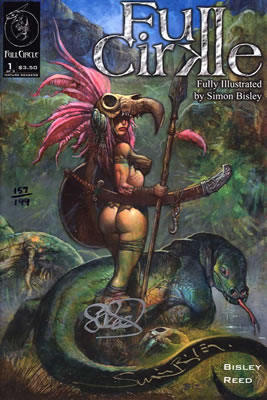 Fantasy comic books are hot again. After the self-destruction of publisher CrossGen, the genre fell off the map. But with the incredible success of Dark Horse Comics’ Conan (and probably in no small part the ripple effect of the Lord of the Rings trilogy) sword and sorcery is back on top. Everyone wants in on the action. Hell, even DC and Marvel have transformed superhero titles Aquaman and The Incredible Hulk into barbarian fantasy tales. And sandwiched in between the inordinate amount of space the big guys command on the shelves is artist Simon Bisley’s Full Cirkle – a worthy entry into the current pantheon of fantasy comic books. A very worth entry indeed.
Fantasy comic books are hot again. After the self-destruction of publisher CrossGen, the genre fell off the map. But with the incredible success of Dark Horse Comics’ Conan (and probably in no small part the ripple effect of the Lord of the Rings trilogy) sword and sorcery is back on top. Everyone wants in on the action. Hell, even DC and Marvel have transformed superhero titles Aquaman and The Incredible Hulk into barbarian fantasy tales. And sandwiched in between the inordinate amount of space the big guys command on the shelves is artist Simon Bisley’s Full Cirkle – a worthy entry into the current pantheon of fantasy comic books. A very worth entry indeed.
Full Cirkle takes place on a prehistoric fantasy world dominated by tribes of warriors that adopt various animals as totems and inspiration for their behavior, manner of dress and fighting styles. Once united, the tribes are now divided after years of in-fighting and territorial disputes. The circle is broken. And from this chaos, two prominent figures emerge – Ashen from Clan Phoenix and Tagar from Clan Sabre – both seeking to reunite the Clans, though for different purposes. But when a mysterious third force threatens all the Clans, Ashen and Tagar’s true loyalties are put to the test. Ungodly amounts of bloody mayhem ensue.
If you absolutely need Lord of the Rings-esque complexity out of your fantasy, then Full Cirkle may or may not be for you. But if you dig the pulpish sensibilities of Frank Frazatta’s Fire and Ice, then Full Cirkle is your kind of book. The setting is exotic. The women are full-figured and voluptuous. The warriors are ass-kickin’ muscle stacked on muscle. The character designs – patterned after various animals – are wonderfully bizarre. And, oh, did I mention the ungodly amounts of bloody mayhem? Suffice it to say, this book is a hell of a lot of fun.
Full Cirkle is not without its imperfections. The dialogue jumps in and out of authenticity, and the story accelerates its conclusion to set up a second (upcoming) Full Cirkle series. But as a whole, this series (three issues) is a vibrant showcase of Simon Bisley’s remarkable artistic talent, and an unapologetic display of pulp and high adventure.
(If you have trouble finding Full Cirkle 1-3 at your comic shop, look for it online at www.fcp.cc)
RATING: 
Mr. Jones KNOWS Something Is Happening Here—Desolation Jones #6
By Jeb D.
 J.H. Williams III will likely be forever remembered as the guy who drew Promethea. No bad thing, really: any artist working with Alan Moore has to be resourceful, and Promethea presented Williams with more unusual challenges than many artists face in a career, including a final issue that required removing the staples and laying the pages out on the floor to be viewed properly. The result was probably the most beautifully illustrated comic of the past decade, and established Williams among the top artists working today.
J.H. Williams III will likely be forever remembered as the guy who drew Promethea. No bad thing, really: any artist working with Alan Moore has to be resourceful, and Promethea presented Williams with more unusual challenges than many artists face in a career, including a final issue that required removing the staples and laying the pages out on the floor to be viewed properly. The result was probably the most beautifully illustrated comic of the past decade, and established Williams among the top artists working today.
Desolation Jones has been an interesting followup for Williams (inking himself this time, but with coloring from his Promethea partner Jose Villarrubia): in contrast to Promethea’s flights of poetry and mysticism, it’s a pretty straightforward “noir”-style detective story, that’s derived much of its resonance from the art. Williams’ work rewards careful reading. He can do panel layouts that are swift and sure and to the point, moving the reader through the story at a furious pace; he’s also capable of jiggering the panels in a way that can take a second or third reading to fully absorb. Admittedly, there are times when it just feels showy: a penciled image of a character is followed by one that looks like a photograph of the same pose, with no indication of a perspective shift that would justify it. Still, a talent this massive can be excused for showing off a bit. Character faces leap to life (Jones himself is unforgettable), and the action scenes are thrilling. Williams is certainly one of the few artists working today whose name on any project will automatically make it worth a look.
Which is a good thing for writer Warren Ellis, because I’m not sure there’s enough going on in his post-modern noir to grab the typical comic reader otherwise.
It’s not a bad story, by any means: a riff on Raymond Chandler’s The Big Sleep, involving dark family secrets and Hitler porn, with the principal twist being that the detective, himself, is the most damaged character of all. But the meat of the tale is nothing we haven’t seen before, and the most compelling material (the horrifying nature of Jones’ condition, the discursions on the business of porn, and the character of Emily Crowe, the “reverse femme fatale,” who is one of Ellis’ most fascinating and poignant creations) is actually pretty peripheral to the story at hand. It’s easy to get to the end of an issue and care less about unraveling the mystery than about spending more time with the secondary characters. With last issue having been devoted to Jones’ explication of the case, the decks are cleared for issue #6’s blood-soaked conclusion. As you’d expect, it’s not exactly a jumping-on point, but anyone reading the series won’t feel shortchanged at the climax.
Supposedly, Ellis has several years’ worth of stories for the series ready to go, if Wildstorm decides to keep it going (and with Planetary about to wind up, it would seem likely they’d want to keep Ellis on the “active list”). That’s a longer career than Sam Spade had, but as long as Williams stays on board, I’m interested to see what else Ellis has up the sleeve of his battered trenchcoat.
RATING: 
The Tourist is a Thrilling Character Noir from Brian Wood and Toby Cypress
By Mark Wheaton
 There’s something just so great and delectably simple about the Brian Wood-penned stand-alone comic, “The Tourist” which feels like a noir taken straight from the canon of Jim Thompson or Cornell Woolrich. All the elements are here – a lonely town in the middle of nowhere, a drifter with a past, a lovely single mother who has spent a lifetime turning away the hamlet’s simpletons only to fall head over heels for the mysterious stranger.
There’s something just so great and delectably simple about the Brian Wood-penned stand-alone comic, “The Tourist” which feels like a noir taken straight from the canon of Jim Thompson or Cornell Woolrich. All the elements are here – a lonely town in the middle of nowhere, a drifter with a past, a lovely single mother who has spent a lifetime turning away the hamlet’s simpletons only to fall head over heels for the mysterious stranger.
This “stranger” is soon revealed to be an incredibly dangerous drug smuggler who has some serious firepower trying to locate him, despite his attempts to bury himself away in an oil rig town on the
Moss is the drifter’s name and we meet him through his own narration – revealing to the reader up front what a duplicitous bad man he is, though we’re not sure where that’ll lead. Moss meets waitress Julie Tucker at the local café and a little flirtatious banter later and he’s in her bed. To complete his “cover,” he takes a job on the town’s oil rig as a welder and then just waits for his pick-up.
But then he kills those who gets in his way. Callously, cold-bloodedly and – most importantly – without getting caught.
Unlike some of the best Thompson (or hell, Charles Willeford), “The Tourist” is a rather simple story – not circuitous beyond a couple of plot twists – that follows genre convention all the way through. What elevates it is Wood’s writing of Moss, particularly his thoughts, coupled with the minimalist line drawings of Toby Cypress. Together, they combine to make “The Tourist” a surprising and well-told tale that would find itself at home within the pages of such a fine journal as “Black Mask.”
RATING: 
![]()

Pacify
(Image)
By Dave Davis
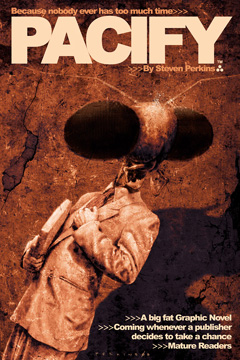 The protagonist of Steven Perkins’ Pacify is an incredibly prosperous celebrity who happens to possess the ability to emit the necessary pheromones to swiftly seduce any woman alive. His name is Sarcophaga… and he has the head of a gigantic fly. Despite his success in business and the bedroom, Sarcophaga won’t feel complete until he exacts revenge on the man who created him (in a scheme to eradicate women from the world) – his father Hans Tsondo, a blind megalomaniac who uses his heightened sense of taste to “see”.
The protagonist of Steven Perkins’ Pacify is an incredibly prosperous celebrity who happens to possess the ability to emit the necessary pheromones to swiftly seduce any woman alive. His name is Sarcophaga… and he has the head of a gigantic fly. Despite his success in business and the bedroom, Sarcophaga won’t feel complete until he exacts revenge on the man who created him (in a scheme to eradicate women from the world) – his father Hans Tsondo, a blind megalomaniac who uses his heightened sense of taste to “see”.
If you think the pitch is strange, well… the book is even stranger. It also borders on brilliant. Accompanied by Perkins’ remarkable painted artwork (which appears to be a combination of traditional method and digital chicanery), the unique story of Sarcophaga is a surreal satire filled with subversive swipes at entertainment, fashion, morality, sensationalism, idolatry and the advertising world (clever counterfeit ads are interspersed throughout the book), and the various levels of manipulation behind each.
With its anthropomorphic hero in search of personal answers, Pacify reminded me of John Mueller’s underappreciated fully painted man-pig series Oink (a deconstruction of organized religion), though Perkins’ stunningly accomplished art is also reminiscent of veterans like Kent Williams and Bill Sienkiewicz and more recent guys like Ben Templesmith and Ashley Wood. And while the artistic style may be an acquired taste and the narrative not overtly accessible, it congeals into a rather significant achievement in storytelling.
Hans Tsondo would be proud of Pacify: the experiment is a triumph.
RATING: 
The Spirit Archives Vol. # 18
(DC Comics)
By Elgin Carver
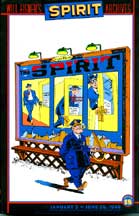 In 1940 the comic section in many newspapers was either augmented or replaced by a comic book style addition whose main protagonist was The Spirit, a creation of Will Eisner. A noir-like detective with no powers other than his brains and police background, aided the authorities in their attempt to restrict the activities of evildoers. Stylish from the beginning, this "book" rapidly progressed, even when Eisner was drafted and others took over the drawing chores.
In 1940 the comic section in many newspapers was either augmented or replaced by a comic book style addition whose main protagonist was The Spirit, a creation of Will Eisner. A noir-like detective with no powers other than his brains and police background, aided the authorities in their attempt to restrict the activities of evildoers. Stylish from the beginning, this "book" rapidly progressed, even when Eisner was drafted and others took over the drawing chores.
When he returned, his style had matured and developed into one of the most recognizable and pleasing drawing styles in the business. Coupled with the fact that Eisner is generally considered one of the best (if not the best) storytellers, this is one knockout combination. In this volume we find him at the peak of his abilities, with few missteps. Solid stories, solid drawing, solid value. The master of the splash page and mood, cranking out a weekly eight page story for the masses. Comics could do with a little of this today.
Help magazine printed many of these stories in the 1960s, in black and white, intentionally, so that those of us whose papers never carried the strip, or who were too young to have read them, could be introduced. There has been an almost continual stream of reproductions since that time in assorted ways and means. None have approached this set. Reproduced on quality paper in standardized hard-bound books, in chronological order, and with voluminous commentary, each book in the set is worthy. This one and the last are among the best. With only six or seven books left to complete the set, rush to get these. Eisner, alas, died about a year and a half ago. In these books, his work will live on for decades, if not centuries. A tip of the hat to DC for doing this the right way and for the right reasons.
RATING: 
Ravenous TPB
(Speakeasy)
By Jeb D.
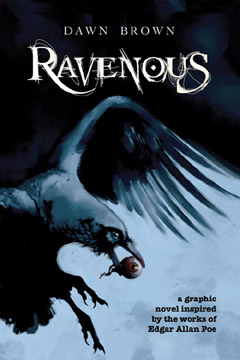 I don’t think Edgar Allen Poe predicted the rise of the modern serial killer. But then, I didn’t used to think that women wrote bloody stories of murder and madness, so that just goes to show what I know. Ravenous is an interesting attempt to use Poe as a jumping-off point for a modern tale of serial murder.
I don’t think Edgar Allen Poe predicted the rise of the modern serial killer. But then, I didn’t used to think that women wrote bloody stories of murder and madness, so that just goes to show what I know. Ravenous is an interesting attempt to use Poe as a jumping-off point for a modern tale of serial murder.
Ravenous artist/writer Dawn Brown is principally a set designer for films (having worked on movies like “Big Fish” and “Solaris”), best known to comic fans for her “Little Red Hot” series (this book was begun during her recent work on the film “The Island”). Ravenous takes five stories from Edgar Allen Poe, and uses them as the starting point for a modern “tale of mystery and imagination.” She quotes Poe as believing that “every moment holds the possibility for sanity to crumble into madness”, and that sums up Ravenous pretty well.
In the small town of Good Fortune, Mason, a young police detective, is drawn into the hunt for a serial killer. We’re shown the early murders in gory detail: the victims are sliced in two. Mason has an active imagination, and a romantic fantasy life, and as the killings accelerate, he begins to attribute them to some supernatural power—a power from which he believes he must protect Catherine, another detective whom he loves from afar (and who barely notices him at all). Murder piles upon murder, the killer becoming so unstoppable as to be practically a force of nature, with Mason searching for clues in the dark fantasies that fill his vision. Whether the reader is wholly satisfied with the answers he comes up with depends as much on Poe as on Brown.
Brown’s visual style is somewhat reminiscent of Fables cover artist James Jean, the colors and texture rich during the day, deeply bleak at night. She varies her page layout approach, mixing long sections of internal monologue laid out side-by-side with the illustrations, with conventional word balloon sequences, though she keeps the story easy to follow, at least visually. As you might expect from a designer, Brown is stronger with the static elements than with action, and her characters are more persuasive in thoughtful repose than in motion. The color palette is ideally suited to the vision of a man for whom “normalcy” is becoming harder and harder to tell from madness.
While Brown’s unquestionably a talented visual artist, she’s taken on a scripting challenge here that would daunt many veteran writers: not only is she adapting themes and incidents from the Poe stories, but she’s borrowing meter and rhyme scheme as well, while still trying to keep the contemporary veneer. There are times it moves close to achieving the dark poetry she’s looking for, in other places, it just comes off as hopelessly awkward and clumsy.
And while I generally like to avoid spoilers when I write a review, the fact that Brown is specific about the Poe stories she’s used as inspiration (even to the point of including the complete texts of them all in an appendix) means that anyone who’s read them is going to have a pretty good idea where the story’s headed: not literally word-for-word, of course—but you’ll find yourself more likely to nod in acknowledgement than gasp in surprise at some new plot twist.
For those who’d like to try an interesting experiment in the blending of disparate literary forms, Ravenous is certainly a visual treat (and a very generous package), and may prove a satisfying read, despite its less-than-comfortable attempt to squeeze Poe into modern serial-killer clichés.
RATING: 
Arsenic Lullaby tpb Volume 2: The Donut Cometh
(Arsenic Lullaby Publishing)
By Graig Kent
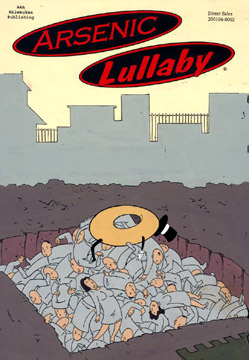 There can be a fine line between funny and bad taste, and with each story in Douglas Paszkiewicz’s second Arsenic Lullaby trade paperback he doesn’t so much straddle the line as he does push it further. It’s not that Paszkiewicz is crude or mean, nor are his illustrations graphic, but he does find the humor in the most unexpected of places, things which may still strike a raw nerve in some people who won’t be able to see past the concept to the actual comedy.
There can be a fine line between funny and bad taste, and with each story in Douglas Paszkiewicz’s second Arsenic Lullaby trade paperback he doesn’t so much straddle the line as he does push it further. It’s not that Paszkiewicz is crude or mean, nor are his illustrations graphic, but he does find the humor in the most unexpected of places, things which may still strike a raw nerve in some people who won’t be able to see past the concept to the actual comedy.
Favorite settings for Arsenic Lullaby include concentration camps, abortion clinics and hunger-starved Etheopia, which most would agree aren’t exactly the happiest places on Earth (EuroDisney perhaps a more apt comparison). Yet, Paszkiewicz, with a wry, absurd wit is able to make me laugh out loud (if with a slight groan) when he does things such as placing the Pillsbury Dough Boy in Auschwitz or show the embarrassing side of a high school bathroom abortion. Yeah, the strips can be pretty raw, but a comfortable, easy line, and the simplistic cartoon caricatures from Paszkiewicz’s pen offer safe detachment from reality.
Back from the previous volumes are such characters as: Voodoo Joe and his army of zombie foetuses (helping people get their vengeance in as lazy a manner as possible); the cow-like aliens and their devious, spirit crushing ways; the Clot (the man without skin) and his sad sack foibles; the many secret government conspiracies you never hear about, along with the many science experiments gone wrong; and the life and humorously depressing times of Baron Von Donut, the Spirit of Breakfast. Paszkiewicz handles all stories with an element of respect, an element of surrealism, and sometimes just sheer silliness. He pulls it off in every instance, but it’s really dark edge comedy, verging on opaque. Not for everyone, but highly recommended.
RATING: 
Little Lulu Vol. 9: Lucky Lulu
(Dark Horse Books)
By Elgin Carver
 Dark Horse is in the process of reprinting what is the best non-superhero comic ever created, with the possible exception of the Carl Barks’s duck books. Where Barks often brought us an epic story with sweeping panoramas, John Stanley and Irving Tripp create stories much more closely related to Krazy Kat or the Peanuts strip with intimate and simple relations between a limited cast in a restricted locale. Unlike the Peanuts angst, Lulu and her friends are children off on children’s adventures from a child’s viewpoint. As in Krazy Kat, the here situations are often repetitive but with deep explorations of the possibilities contained within such situations.
Dark Horse is in the process of reprinting what is the best non-superhero comic ever created, with the possible exception of the Carl Barks’s duck books. Where Barks often brought us an epic story with sweeping panoramas, John Stanley and Irving Tripp create stories much more closely related to Krazy Kat or the Peanuts strip with intimate and simple relations between a limited cast in a restricted locale. Unlike the Peanuts angst, Lulu and her friends are children off on children’s adventures from a child’s viewpoint. As in Krazy Kat, the here situations are often repetitive but with deep explorations of the possibilities contained within such situations.
Lulu, her closest friend Annie, Alvin, Tubby (Lulu’s bane), Iggy, and the "fellers" (Tubby’s neighborhood boys club, whose names are seldom mentioned) constitute the characters, although adults and other children drift in and out of the stories. The adventures take place in their local area or in Lulu’s imagination. Lulu, an innocent in the mold of the Kat, and her adventures are as simple, baby-sitting, going to the store for her mother, playing with the children that live around her. Tubby is often the center of attention, a pompous, self-important but innocent trouble maker, often getting Lulu in and out of scrapes, solving "crimes," and aggravating Lulu’s father.
Rainbow Publishers reprinted the entire series some years ago in 18 oversized hardbound volumes, issued in slip-cased sets of three. These contain commentary, black and white interiors, and color cover reproductions. Three of the sets are fairly expensive but relatively common and can be had at on-line auctions with little difficulty. Two are much harder to find with escalating prices. The other set is quite rare and very expensive. These Dark Horse editions are smaller than the originals, soft-bound, with no commentary to speak of (a major oversight), black and white interiors, and no cover reproductions at all. However the issues are readily available through your local comic shop, and the price is quite reasonable. You owe it to yourself to pick up this book and the previous eight volumes.
RATING: 
![]()

 Blackgas #2 (Avatar) – Warren Ellis goes zombie apocalypse with the cinematic “Blackgas,” a Stephen King-like tale that has a guy taking his new girlfriend home to meet his parents on an isolated, summertown-type island only to have a seismic shift release the titular “black gas” that turns a large percentage of the town into zombies. Though pretty standard fare, Ellis’s writing still manages to make interesting choices with the characters in order to turn an oft-recycled plot into something actually worth checking out – albeit perhaps just eventually in trade paperback form. While “Desolation Jones” is the Ellis must-read of the week, “Blackgas” is still better than, say, “Escape of the Living Dead,” so if you’re a zombie-fan, check it out. – Mark
Blackgas #2 (Avatar) – Warren Ellis goes zombie apocalypse with the cinematic “Blackgas,” a Stephen King-like tale that has a guy taking his new girlfriend home to meet his parents on an isolated, summertown-type island only to have a seismic shift release the titular “black gas” that turns a large percentage of the town into zombies. Though pretty standard fare, Ellis’s writing still manages to make interesting choices with the characters in order to turn an oft-recycled plot into something actually worth checking out – albeit perhaps just eventually in trade paperback form. While “Desolation Jones” is the Ellis must-read of the week, “Blackgas” is still better than, say, “Escape of the Living Dead,” so if you’re a zombie-fan, check it out. – Mark
RATING: 
 Star Wars: Rebellion # 1 (Dark Horse Comics) – Proving once again that the best Star Wars stories since the Original Trilogy have appeared on paper not celluloid, Dark Horse rolls out another promising ongoing Star Wars title this week with Rebellion. Set between A New Hope and The Empire Strikes Back, Rebellion follows the Alliance as they attempt to win support throughout the galaxy after their first convincing victory against the Empire, who – needless to say – is mighty pissed after losing the ultimate WMD. This inaugural issue is told from the perspective of Janek Sunber, one of Luke Skywalker’s childhood friends on Tatooine and now an officer in the Imperial Navy. Series writer Rob Williams, does a great job making Janek a sympathetic character, and explores his confusion over the civil war and where his loyalties should lay. But ultimately, Janek believes in the Empire’s mission to restore order, and this makes him more compelling, as well as sets up an interesting narrative and philosophical dynamic between himself and Luke. Fans have longed to have this period of the Star Wars mythology more deeply explored, and Rebellion delivers with exciting and character driven storytelling. – Sean
Star Wars: Rebellion # 1 (Dark Horse Comics) – Proving once again that the best Star Wars stories since the Original Trilogy have appeared on paper not celluloid, Dark Horse rolls out another promising ongoing Star Wars title this week with Rebellion. Set between A New Hope and The Empire Strikes Back, Rebellion follows the Alliance as they attempt to win support throughout the galaxy after their first convincing victory against the Empire, who – needless to say – is mighty pissed after losing the ultimate WMD. This inaugural issue is told from the perspective of Janek Sunber, one of Luke Skywalker’s childhood friends on Tatooine and now an officer in the Imperial Navy. Series writer Rob Williams, does a great job making Janek a sympathetic character, and explores his confusion over the civil war and where his loyalties should lay. But ultimately, Janek believes in the Empire’s mission to restore order, and this makes him more compelling, as well as sets up an interesting narrative and philosophical dynamic between himself and Luke. Fans have longed to have this period of the Star Wars mythology more deeply explored, and Rebellion delivers with exciting and character driven storytelling. – Sean
RATING: 
 Ms. Marvel #2 (Marvel). Given that the first issue of this title hit the Top Ten for March, my earlier prediction of the book not lasting six issues was probably off the mark. Issue #2 fulfills the promise of #1: Brian Reed is fashioning a well-written “old school” Marvel superhero story: that is, our heroine alternates an interesting backstory, self-doubt, and jokes, with page after colorful page of super-powered throwdown with the nasty alien menace The Brood… only to find out that there’s something even they’re scared of. Artist Roberto De La Torre hits all the right notes here, pulling out the stops while Ms Marvel’s in action, but always letting us see the range of expression in the eyes beneath the mask. Whether Ms. Marvel can sustain its sales momentum without that big “#1” on the cover (or Michael Turner cover variants) remains to be seen, but as an example of how much pleasure can still be derived from the old Marvel formula, it’s a worthwhile read. –Jeb D.
Ms. Marvel #2 (Marvel). Given that the first issue of this title hit the Top Ten for March, my earlier prediction of the book not lasting six issues was probably off the mark. Issue #2 fulfills the promise of #1: Brian Reed is fashioning a well-written “old school” Marvel superhero story: that is, our heroine alternates an interesting backstory, self-doubt, and jokes, with page after colorful page of super-powered throwdown with the nasty alien menace The Brood… only to find out that there’s something even they’re scared of. Artist Roberto De La Torre hits all the right notes here, pulling out the stops while Ms Marvel’s in action, but always letting us see the range of expression in the eyes beneath the mask. Whether Ms. Marvel can sustain its sales momentum without that big “#1” on the cover (or Michael Turner cover variants) remains to be seen, but as an example of how much pleasure can still be derived from the old Marvel formula, it’s a worthwhile read. –Jeb D.
RATING: 
 30 Days of Night: Dead Space #3 (IDW) – Every further “30 Days of Night” series will always live in the shadow of Ben Templesmith’s artwork from the first run, but the work of Milx in “Dead Space” certainly aims to change that. In one of the most artfully disgusting entries in the title, we find vampires in space taking over a space shuttle, then a space station – wiping out all the researchers and astronauts as they go in lavishly gory fashion. In issue #3 this continues with new sub-zero gravity vampire-action making for some of the most fun pages in the book. The plot, however, kind of spins to its inevitable conclusion, which feels like a lengthier version than one of the “Bloodsucker Tales.” That said, the art alone elevates this book above, say, the storyboard-feeling “Full Moon Fever” that’s plot was similarly by-the-numbers, but didn’t look anywhere near as good doing it. – Mark
30 Days of Night: Dead Space #3 (IDW) – Every further “30 Days of Night” series will always live in the shadow of Ben Templesmith’s artwork from the first run, but the work of Milx in “Dead Space” certainly aims to change that. In one of the most artfully disgusting entries in the title, we find vampires in space taking over a space shuttle, then a space station – wiping out all the researchers and astronauts as they go in lavishly gory fashion. In issue #3 this continues with new sub-zero gravity vampire-action making for some of the most fun pages in the book. The plot, however, kind of spins to its inevitable conclusion, which feels like a lengthier version than one of the “Bloodsucker Tales.” That said, the art alone elevates this book above, say, the storyboard-feeling “Full Moon Fever” that’s plot was similarly by-the-numbers, but didn’t look anywhere near as good doing it. – Mark
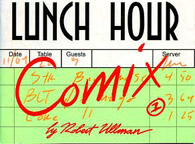 Lunch Hour Comix # 1 (Alternative Comics) – Robert Ullman set himself the task of drawing a one page comic diary during a year which involved moving, being newly married, buying a house, as well as daily events. Each strip was to take an hour or less to draw. As with most diaries,
Lunch Hour Comix # 1 (Alternative Comics) – Robert Ullman set himself the task of drawing a one page comic diary during a year which involved moving, being newly married, buying a house, as well as daily events. Each strip was to take an hour or less to draw. As with most diaries,
